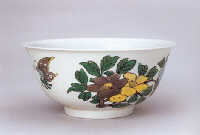
During the Zhengde reign of the Ming Dynasty(1368-1644), a type of colored-glazed porcelainfeaturing three major colors -- yellow, green and purple -- became very popular in Jingdezhen, Jiangxi Province. Owing to its plainness and neatness, as well as its simplicity and elegance, it was also given another name -- plain tri-colored porcelain, or "Susancai".
Plain tri-colored glazed porcelain refers to a kind of over-glaze decoration with yellow, green or purple as the dominant colors. The art was brought into being in the early Ming Dynasty and had flourished by the Zhengde reign. It was further developed during the reign of Emperor Kangxi of the Qing Dynasty(1644-1911) when a special blue shade was added.
The making of plain tri-colored glazed porcelain in the Ming Dynasty consisted of two steps. First of all, drawings and patterns of various kinds were carved into the porcelain flan without a ceramicglaze, which was then fired at a high temperature. After that, drawings and patterns of various kinds were colored and fired at a low temperature. Except for the three major colors, white and black were also frequently employed. As a kind of porcelain, the plain tri-colored glazed porcelain is different from the tri-colored glazed pottery of the TangDynasty (618-907), which is a low-melting glazed pottery.


Plain tri-colored glazed porcelain utensils from the Ming Dynasty include three-legged bowls and furnaces. By the time of Kangxi, plain tri-colored glazed porcelain prevailed. The products, which were usually vividly sculpted, included bowls, plates, stationeries and stoves. Sometimes, even the Kwan-yin Statues and incense burners employed this art, which was more exquisite and the base colors more varied, including yellow and green bases. There was also a tiger-skin tri-colored glazed porcelain, which was made by dappling yellow, green and purple. During the firing process, the porcelain would naturally form a pattern likening that of a tiger's coat.
Of all the tri-colored glazed porcelain, ink-base tri-colored porcelain, which became popular during Kangxi's reign, is the most exquisite and precious.
(Source: chinaculture.org)










